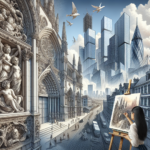Photorealistic rendering is a technique used in computer graphics to create images that closely resemble real-life photographs. This technology has become increasingly popular in the fields of architecture, interior design, product design, and advertising, as it allows for the creation of highly realistic and detailed imagery for various purposes. While the end result may look simple to the untrained eye, the process of achieving photorealistic rendering is actually quite complex, involving advanced software, powerful hardware, and skilled artists.
At the heart of photorealistic rendering is the use of specialized software that allows artists to create lifelike images with a high level of detail and realism. These software programs, such as Autodesk 3ds Max and Blender, provide artists with a wide range of tools and settings to manipulate lighting, textures, materials, and camera angles to achieve the desired result. Artists can also use plugins and external renderers, such as V-Ray and Octane Render, to further enhance and optimize the rendering process.
One of the key components of achieving photorealistic rendering is the use of physically-based rendering (PBR) techniques. PBR is a rendering methodology that simulates the physical properties of materials, such as how they reflect and absorb light, to create realistic textures and materials in the final image. By accurately representing the behavior of light in the virtual scene, PBR helps to create a more believable and immersive image that closely mimics real-world lighting conditions.
To further enhance the realism of a photorealistic rendering, artists must pay close attention to details such as shadows, reflections, and depth of field. Shadows add depth and dimension to the scene, while reflections help to create a sense of realism by mimicking how light interacts with different surfaces. Depth of field, on the other hand, allows artists to simulate the way in which objects at different distances from the camera appear in focus or out of focus, just like in a real photograph.
In addition to software and techniques, achieving high-quality photorealistic rendering also requires powerful hardware to handle the complex calculations and rendering processes involved. Artists often rely on high-performance computers with advanced graphics cards, processors, and memory to render large and detailed scenes efficiently. Additionally, some artists use render farms, which are networks of computers working together to render images faster by distributing the workload across multiple machines.
Despite the advancements in technology and software, achieving photorealistic rendering still requires a great deal of skill and artistic vision. Artists must have a strong understanding of lighting, composition, color theory, and other principles of visual arts to create compelling and realistic images. They must also be patient and detail-oriented, as rendering complex scenes can be time-consuming and require a meticulous attention to detail to achieve the desired result.
Overall, photorealistic rendering is a powerful tool that allows artists and designers to create stunning and realistic imagery for various applications. By leveraging advanced software, techniques, and hardware, artists can bring their creative visions to life in a way that is almost indistinguishable from a real photograph. As technology continues to evolve, the possibilities for photorealistic rendering are endless, and the boundary between virtual and reality will continue to blur.




